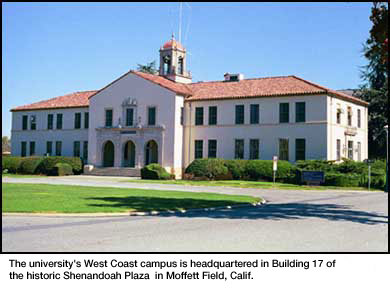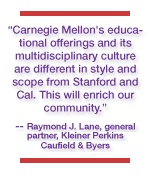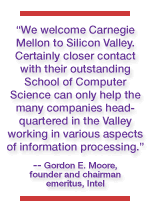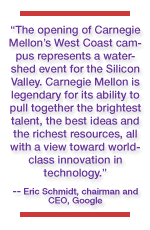|
|
||||||||||||||||||||||||||||||||||||||||||
|
|
 Carnegie Mellon Hosts Founders' Day at West Coast Campus
Carnegie Mellon University recently hosted a Founders' Day celebration to honor Silicon Valley leaders who together have donated more than $1 million to support the establishment of the university's new West Coast campus. The event was held in Building 17 of the Shenandoah Plaza in Moffett Field, Calif., where the campus is located.
Carnegie Mellon's West Coast campus opened for classes in September 2002, with 56 students enrolled in two programs leading to a master of science degree in information technology. The course of study is built around project-oriented, apprenticeship-based and individually mentored activities that emphasize teamwork and collaboration.
"We welcome Carnegie Mellon to Silicon Valley," said Gordon E. Moore, founder and chairman emeritus of Intel. "Certainly closer contact with their outstanding School of Computer Science can only help the many companies headquartered in the Valley working in various aspects of information processing. We hope the close association will be mutually beneficial."
The campus also has a research agenda based on high dependability computing. Carnegie Mellon received $23.3 million from NASA in January 2002 to lead the High Dependability Computing Project (HDCP), a research consortium of five universities. The work has initially focused on identifying dependability issues for NASA software and developing potential solutions, such as working with Sun Microsystems and the California Institute of Technology's Jet Propulsion Laboratory (JPL) to create a Java version of JPL's architectural framework for mission-critical, real-time control systems.
"Carnegie Mellon's strong focus on all aspects of software engineering, including robotics, speech and digital libraries will be beneficial to the Valley and to Carnegie Mellon," Bell said. "I am delighted to see it arrive."
"We are generating a unique educational method of learning by doing to the field of software engineering and it seems to work perfectly with the Silicon Valley culture," said James H. Morris, dean of Carnegie Mellon's School of Computer Science who has been instrumental in establishing the university's West Coast initiative. "With its reality-based research programs and professional education, our West Coast campus brings great value to Silicon Valley companies. It's wonderful that so many leaders of the Valley have chosen to invest in us at a time when investments are hard to come by."
During this time, Carnegie Mellon officials also have been collaborating with officials at NASA's Ames Research Center as they've been developing plans for a research park at Moffett Field. On Nov. 22, NASA signed the Record of Decision for the Environmental Impact Statement for the NASA Ames Development Plan. Its vision is to develop a world-class, shared-use R&D campus in association with academia, industry and nonprofit organizations. "The opening of Carnegie Mellon's West Coast campus represents a watershed event for the Silicon Valley," said Eric Schmidt, chairman and CEO of Google. "Carnegie Mellon is legendary for its ability to pull together the brightest talent, the best ideas and the richest resources, all with a view toward world-class innovation in technology. Welcome to the Valley!" For more information on Carnegie Mellon's West Coast campus, see http://west.cmu.edu/.
Anne Watzman
|
||||||||||||||||||||||||||||||||||||||||
|
Carnegie Mellon Home |
||||||||||||||||||||||||||||||||||||||||||
 More than 20 donors were honored, including some of Silicon Valley's most famous entrepreneurs. (See below for the list of donors.)
More than 20 donors were honored, including some of Silicon Valley's most famous entrepreneurs. (See below for the list of donors.)
 "The more premier educational institutions based in the Valley, the better," added Raymond J. Lane, general partner, Kleiner Perkins Caufield & Byers. "Carnegie Mellon's educational offerings and its multidisciplinary culture are different in style and scope from Stanford and Cal. This will enrich our community."
"The more premier educational institutions based in the Valley, the better," added Raymond J. Lane, general partner, Kleiner Perkins Caufield & Byers. "Carnegie Mellon's educational offerings and its multidisciplinary culture are different in style and scope from Stanford and Cal. This will enrich our community."
 As a former Carnegie Mellon computer science professor (1966-72), Microsoft Senior Researcher Gordon Bell is very familiar with the university's activities.
As a former Carnegie Mellon computer science professor (1966-72), Microsoft Senior Researcher Gordon Bell is very familiar with the university's activities.
 Since 1999, Carnegie Mellon has been working to develop a presence in Silicon Valley—to do research with NASA and Valley companies, establish educational programs, offer special internship and work opportunities to students on the Pittsburgh campus, and develop closer ties with the nearly 3,000 alumni who live and work in the Valley.
Since 1999, Carnegie Mellon has been working to develop a presence in Silicon Valley—to do research with NASA and Valley companies, establish educational programs, offer special internship and work opportunities to students on the Pittsburgh campus, and develop closer ties with the nearly 3,000 alumni who live and work in the Valley.